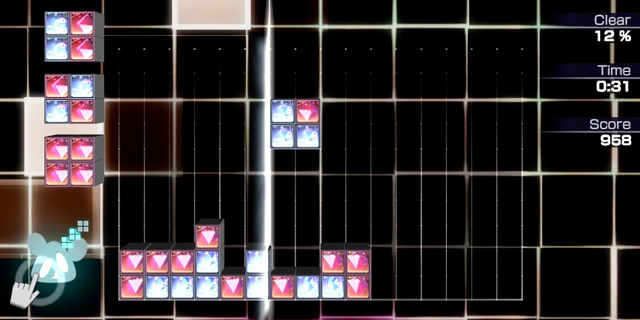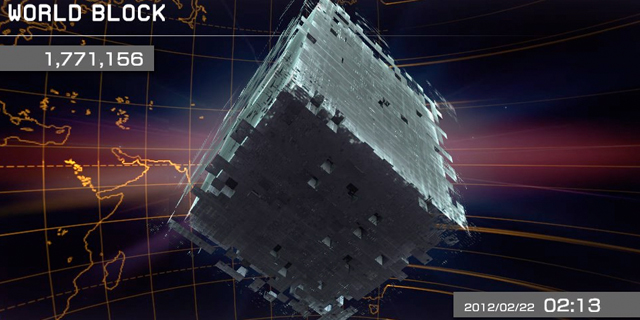
Lumines has been away from handhelds for a while, appearing in two console-exclusive titles, but both failed to re-capture what made the original game so incredible back during the PSP’s launch in 2004. And here we are, eight years later, with Lumines: Electronic Symphony, proving that this franchise feels right at home on a handheld.
The basic groundwork of Lumines has remained unchanged. You rotate falling blocks containing two different colors to match a 2×2 square of the same color. As you do that, a timeline passes by the screen, clearing the color squares that have been created. You can attempt to combo as many squares together as possible before the line passes again, allowing your score to multiply. If the blocks pile too high and reach the top of the screen, it’s game over. It’s simple, and it works just as well today as it did back in 2004.
The thing that separates Lumines from other, similar puzzle games is the music. Each skin contains a different background, block color/shape, and song. As you make combos, it will play along with the beat of the song, which makes getting combos even more satisfying. It’s not a rhythm game, you aren’t doing anything to the beat of the song exactly, but the music is exciting and it adds a lot of enjoyment to a relatively basic puzzle concept. It’s what makes the Lumines experience unique.
The basic Lumines mode is Voyage, which has you clearing skins to gain a high score. Each skin requires you to clear a certain number of blocks and once you reach that goal, the skin changes immediately to the next. If you fail, you can retry from the current skin you are on, but it brings your high score back down to 0. Some Voyage games can last over an hour, but the time goes so fast you won’t even realize it. Trust me, I know.
Other modes include Master, which has you completing challenges for clearing a certain number of blocks, Stopwatch, where you attempt to score as many points as possible in a small time frame, and Playlist, where you select your favorite skins and play them in whatever order you want. There is also Duel mode, which pits you against random Lumines players to compete for high scores. These modes are fun diversions from the Voyage mode and let players experiment with their favorite skins as well as test their own skills under certain limits.
You also choose an avatar, but unlike in previous Lumines titles, they serve a greater purpose beyond aesthetics. Each avatar has a different skill that helps during gameplay, like stopping the Time Line temporarily or changing your next three blocks into single-color blocks. Once you use this power, you have to watch for it to recharge or you can tap the rear touch pad of the Vita to charge it faster. This can be annoying to attempt to do during gameplay, but it might be necessary for achieving high scores.

New to Lumines is the leveling system. As you play Voyage or any other modes, your score translates to XP, which levels you up. As you gain XP, you unlock new skins and avatars. Even if you do horribly in Voyage one day, for example, your score will still earn you XP and you continue unlock new things. It’s a satisfying way to keep people playing and rewarding them for their time. Also new to the series is the World Block. Every 24 hours, a new World Block is created, and if you play the game while connected online, every block you clear while you play will go towards clearing the World Block. Contributing to the World Block (or simply seeing it get cleared) will also earn you a lot of XP. It’s a fun goal to get you checking back and playing every day.
Lumines: Electronic Symphony is more Lumines with a few neat additions. The game looks gorgeous on the Vita’s large screen and the gameplay is as addictive as it has ever been. For some, these small changes might not be enough to warrant a purchase, but I can say with absolute certainty that this is the best Lumines yet. New Vita owners looking for a fun puzzle experience won’t want to miss this.
Pros: Gorgeous presentation, new modes and options are nice, the basic formula is still addictive
Cons: Not many substantial changes to the gameplay



















